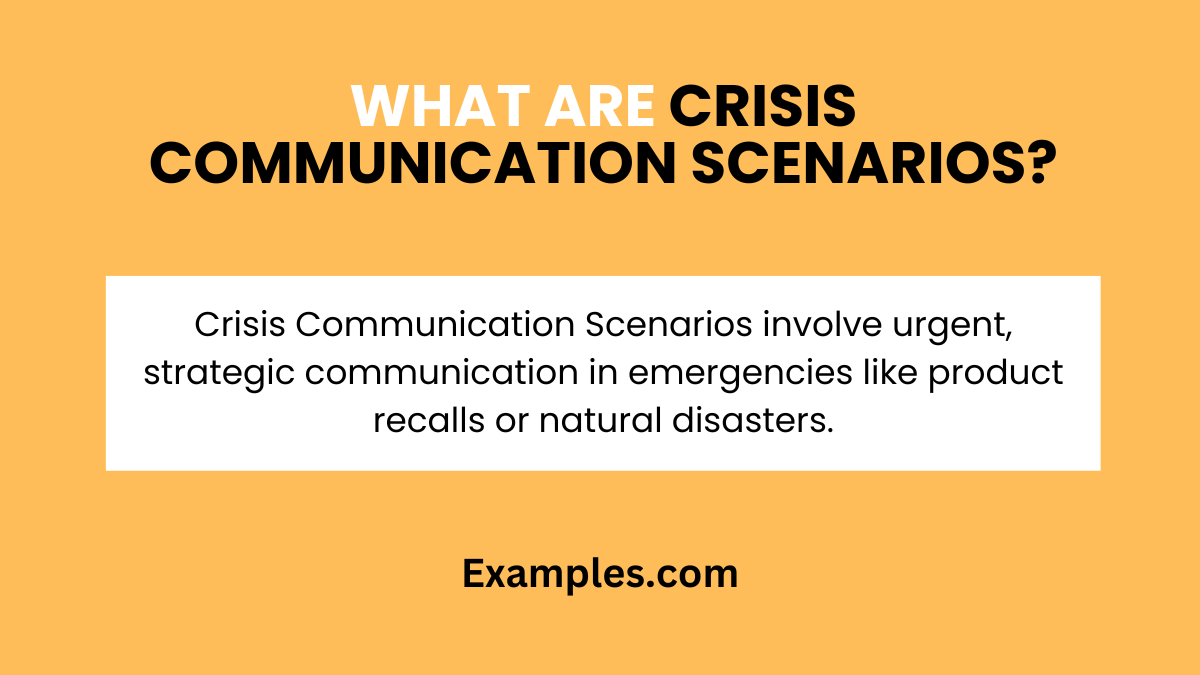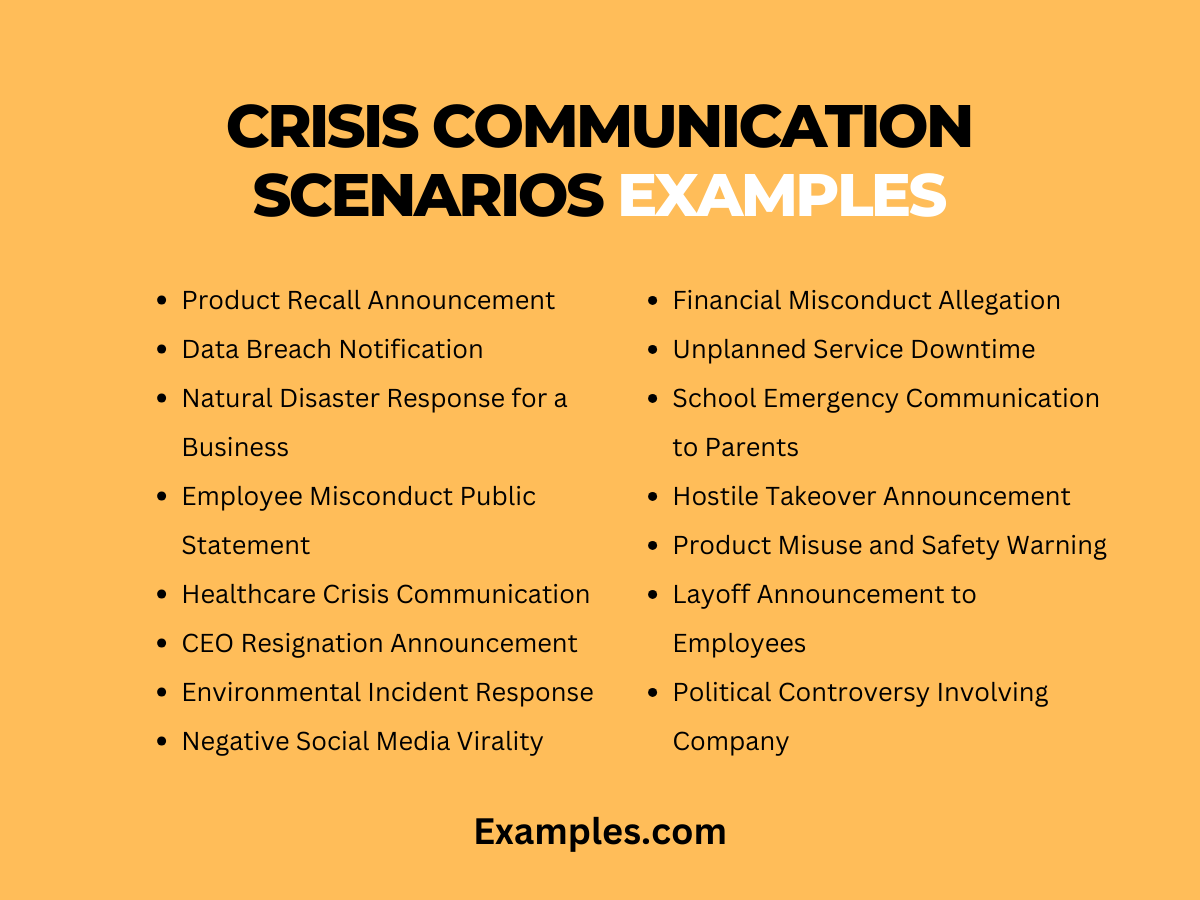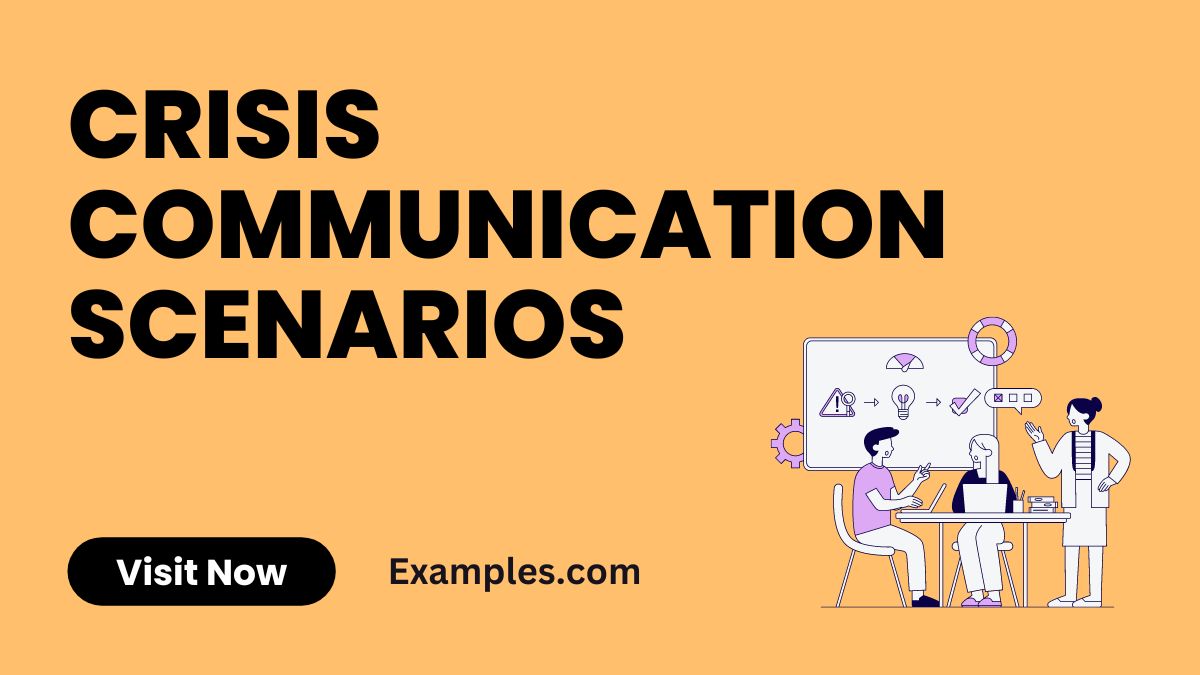Crisis Communication Scenarios
Delve into the crucial world of Crisis Communication Scenarios with this detailed guide. Crises, whether natural disasters, corporate mishaps, or public health emergencies, demand precise and strategic communication. This guide presents a variety of scenarios, each highlighting the importance of effective communication in crisis management. From internal communication breakdowns to public relations disasters, learn how to navigate these situations with clarity and confidence. Understand the role of nonverbal communication, assertive communication, and more in mitigating crises effectively.
What are Crisis Communication Scenarios?

Crisis Communication Scenarios refer to various situations where urgent and careful communication is essential to manage a crisis effectively. These scenarios often involve high-stress conditions where the right choice of words, tone, and communication channels can significantly impact the outcome. From handling a product recall to responding to a natural disaster, each scenario requires a tailored communication approach, considering factors like audience, medium, and timing. Understanding these scenarios is key to preparing and executing an effective crisis communication strategy.
What is the Best Example of Crisis Communication Scenarios?

A prime example of Crisis Communication Scenarios is the management of a major corporate scandal. In such situations, companies face intense public scrutiny, making transparent, timely, and empathetic communication paramount. The scenario involves addressing the media, stakeholders, and the public, often through press releases, social media, and press conferences. The communication strategy should focus on acknowledging the issue, expressing commitment to rectify the situation, and maintaining open lines of communication. This approach helps in rebuilding trust and minimizing long-term damage to the company’s reputation.
15 Crisis Communication Scenarios Examples

- Product Recall Announcement
- Communicating safety concerns and recall details to consumers.
- Example: “For your safety, we are recalling [product] due to [issue]. Here’s how to proceed.”
- Data Breach Notification
- Informing stakeholders about a data breach and protective measures taken.
- Example: “We regret to inform you of a data breach that may have affected your information. Immediate actions have been taken.”
- Natural Disaster Response for a Business
- Addressing stakeholders on business continuity and support during a natural disaster.
- Example: “Our priority is the safety of our employees and customers. Here are our steps for continued service.”
- Employee Misconduct Public Statement
- Addressing the public about an incident of employee misconduct.
- Example: “We are aware of the recent incident and are taking appropriate actions to address it.”
- Healthcare Crisis Communication
- Communicating to the public during a healthcare crisis like a pandemic.
- Example: “Please follow these guidelines to protect yourself and others during this health crisis.”
- CEO Resignation Announcement
- Informing employees and stakeholders about a change in leadership.
- Example: “Our CEO [Name] has resigned. We are committed to a smooth transition and continued growth.”
- Environmental Incident Response
- Communicating about an environmental incident and its impact.
- Example: “We are addressing the recent environmental incident and are committed to restoration efforts.”
- Negative Social Media Virality
- Responding to a situation where the company receives negative attention on social media.
- Example: “We acknowledge the concerns raised and are actively working to address these issues.”
- Financial Misconduct Allegation
- Addressing allegations of financial misconduct within the company.
- Example: “We take these allegations seriously and are conducting a thorough investigation.”
- Unplanned Service Downtime
- Communicating to users about unexpected service interruptions.
- Example: “We apologize for the unexpected service downtime and are working to restore it promptly.”
- School Emergency Communication to Parents
- Informing parents about an emergency situation at a school.
- Example: “Your child’s safety is our priority. Here is the current situation and our actions.”
- Hostile Takeover Announcement
- Addressing employees and shareholders during a hostile takeover.
- Example: “We are currently facing a hostile takeover bid and are exploring all options to protect our interests.”
- Product Misuse and Safety Warning
- Warning consumers about potential misuse of a product and safety risks.
- Example: “Please be advised on the correct use of [product] to ensure your safety. Misuse can lead to…”
- Layoff Announcement to Employees
- Communicating layoffs to employees compassionately and clearly.
- Example: “It is with regret that we announce upcoming layoffs. We are committed to supporting affected employees.”
- Political Controversy Involving Company
- Responding to a company’s involvement in a political controversy.
- Example: “We acknowledge our inadvertent role in this political matter and are committed to remaining apolitical.”
Crisis Communication Scenario Examples for Students
- Campus Safety Threat
- Communicating about a potential safety threat on campus.
- Example: “Please be aware of a reported safety threat on campus. Stay in secure locations and await further instructions.”
- Response to On-Campus Incident
- Addressing students and parents following an incident on campus.
- Example: “We are responding to [incident] on campus. All students are safe, and we are taking appropriate measures.”
- Health Emergency Announcement
- Informing about a health emergency, like an outbreak of an illness.
- Example: “There is a confirmed case of [illness] on campus. Here are the steps we are taking for your safety.”
- Change in Academic Policies
- Communicating sudden changes in academic policies or schedules.
- Example: “Due to [reason], there are changes in the academic schedule. Please see the detailed update on our website.”
- Cancellation of Major Events
- Announcing the cancellation of significant campus events.
- Example: “With regret, we announce the cancellation of [event] due to [reason]. We prioritize the safety and wellbeing of our community.”
What are the Key Elements of Effective Crisis Communication Scenarios?
Effectively managing Crisis Communication Scenarios requires a deep understanding of several key elements. These elements are critical in ensuring that communication during a crisis is impactful, appropriate, and facilitates a swift resolution to the situation. Here are five key elements:
- Clear and Concise Messaging: In a crisis, it’s crucial to convey messages that are easy to understand. Avoiding technical jargon and ensuring clarity prevents misunderstandings and confusion.
- Timely Response: Speed is of the essence in crisis situations. Quick, proactive communication can control the narrative and prevent misinformation from spreading.
- Empathy and Sensitivity: Showing empathy in communication helps in connecting with the affected individuals and demonstrates that the organization cares about their concerns and wellbeing.
- Consistent Information: Providing consistent information across all communication channels is vital to maintain credibility and trust. Mixed messages can lead to doubt and uncertainty.
- Preparedness and Training: Having a well-prepared crisis communication plan and training staff accordingly ensures that when a crisis occurs, the response is coordinated and effective.
What are the Common Crisis Communication Scenarios?
- Natural Disasters and Environmental Crises: Involves communicating safety measures, relief efforts, and updates during events like hurricanes, earthquakes, or environmental disasters. The key is to provide timely, accurate information to ensure public safety and coordinate relief efforts.
- Public Health Emergencies: Requires disseminating critical health information, guidelines, and updates during health crises such as pandemics. It’s essential to convey messages clearly to avoid miscommunication and ensure public adherence to health advisories.
- Data Breaches and Cybersecurity Incidents: Involves informing stakeholders about data security breaches and steps taken to mitigate risks. Transparency and promptness are crucial to maintain trust and manage the potential fallout.
- Corporate Crises: Includes scenarios like product recalls, financial scandals, or executive misconduct. Companies must communicate honestly and take responsibility while outlining steps to rectify the situation and prevent future occurrences.
- Reputational Damage: Addresses crises arising from negative media attention or public perception. The focus here is on restoring reputation through strategic communication, showing accountability, and rebuilding public trust.
In conclusion, this comprehensive guide on Crisis Communication Scenarios offers vital insights and practical tips for effective crisis management. By understanding diverse scenarios and applying key principles of effective communication, organizations can navigate crises with confidence. The guide underscores the importance of preparedness, clarity, empathy, and strategic communication, equipping professionals with the tools to maintain stability and trust in challenging situations.



